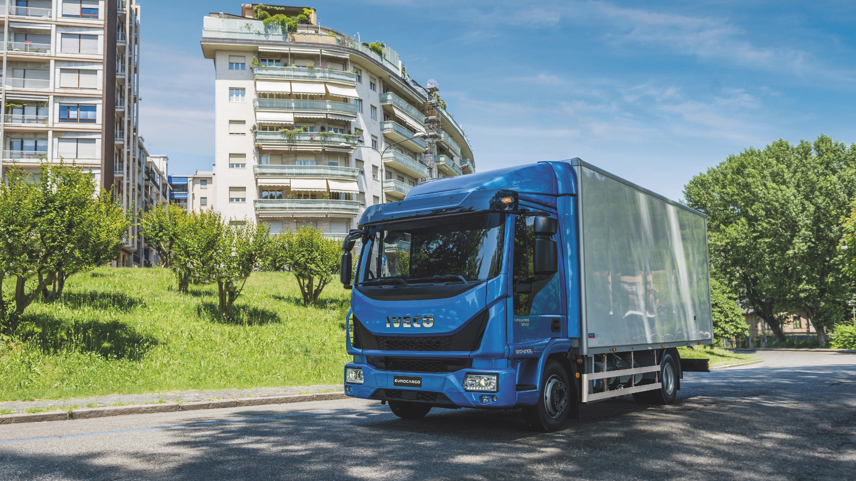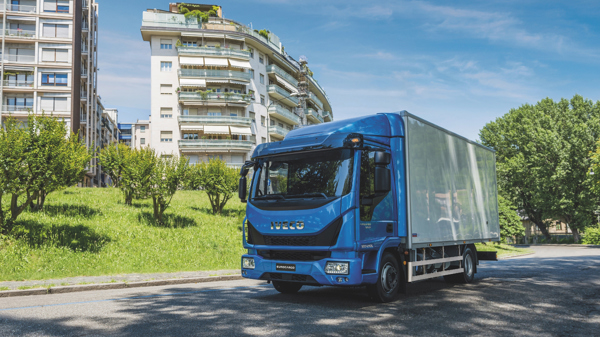Review
Ask most 7.5 tonne GVW operators to name their top three trucks, chances are the Iveco Eurocargo and the DAF LF will be in the mix somewhere and that’s been the case for the last three decades. Of course, the product has changed over this time but the rivalry remains, although the DAF LF has over that time, managed to maintain a lead over its arch rival.
Today’s Iveco Eurocargo is a far cry from the old ‘Cargo’ and has undergone a series of facelifts over the past couple of decades, including the latest driveline upgrade reflecting the recent changes in legislation requiring the Euro VI ‘Step E’ emissions enhancement. Another feature of the ‘7.5 tonne’ market is the increasingly desire for operators to ‘experiment’ with other gross vehicle weights between 3.51 tonne and upto 12 tonne, basically within the N2 category and their driver licencing friendly weights.
As a consequence in this review we are going to look at the latest generation equipped 8 tonne version with the new ‘Step E’ engine based on the Tector 5 diesel rated at 190 bhp, the ML80E19.
Manufacturer nomenclature can be a little confusing, but Iveco’s is relatively simple with the first couple of digits outlining the cab type, the next two numbers the nominal gross vehicle weight multiplied by ten , the single letter the market region and finally the last two numbers the nominal horsepower divide by ten.
Perhaps one of the greatest strengths of the Iveco product line-up over the years has been their engine and driveline combination with all the engines manufactured by their globally recognised ‘in-house company’ Fiat Power Train (FPT) Industrial.
The Tector 5 is a great example of this, rated at a maximum power of 190 bhp ( 137kW) @ 2200 rpm and a maximum torque of 680Nm @ 1100 rpm. That what’s quoted in the Iveco specification sheet and yet if you look at the power and torque curves it shows a much better situation with both power and torque ‘hanging on to their respective maximum limits across a decent rev range. The power curve shows the maximum power is ‘held’ across the rev range from 2000 to 2200 rpm and the torque ‘holds on’ from an impressive 1100 to 1600 rpm, potentially providing a good useable driving range.
The Tector 5 (F4A) displaces 4485 cc and uses the famous Iveco HI-SCR emissions control as well as turbocharging and aftercooling enabling it to reach the latest Euro VI E standard.
The 190 bhp engine’s flywheel connects to a single dry plate 362mm clutch irrespective of which gearbox is chosen. As far as gearboxes are concerned, there are three to chose from, one fully automatic, one automated and finally a synchronized manual, you could say they have a ‘full set’ of options. Most operators specify the six speed automated Astronic with an overdrive top gear, the manual gearbox is simply the same gearbox without the automation system ‘sitting on top ‘ of it. The automatic offering is completely different and comes in the form of the well-known Allison S2500, this a five speed with a maximum torque input of 780Nm, well inside the 680Nm developed by the Tector 5 engine.
As mentioned previously, the truck maybe specified with a day or sleeper cab, there’s even a crew cab variant but in the most cases for the vast majority of UK operators will specify the day cab. This features a three way adjustable driver’s seat with integral head restraint and a dual fixed passenger seat with 50/50 split back rest with head restraints. Overhead there are lockers with doors and document storage on a shelf on passenger side as well as the rear cab wall. Outside there’s a convenient one step cab entry, heated rear view mirrors including two wide angle, one kerb view and one front view mirror and LED day time running lights (DTRL).
There are six wheelbases available on the day cab and four on the sleeper cab, the day cab wheelbases range from the tipper friendly 3105mm to the distribution focussed 4815mm. This translates into overall lengths as chassis cabs of between 5933mm to 8835mm.
Kerb weights for the day cabbed ML80E19 start at 3500kgs and longest wheelbase is 150kgs heavier, if you want the sleeper cab these weights are increased by a further 130kgs, resulting in a sleeper cab long wheelbase weighing in at 3780kgs. These weights are for the vehicle in a standard configuration and include a 75kg driver, a full fuel tank of 120 litres, Adblue, tool kit and spare wheel if fitted. As this is officially an eight tonne gross vehicle weight truck the payloads start at 4500kgs without body and it has a gross train weight of 16500 kgs provided the six speed gearbox and a drawbar pack is specified.
The Iveco 5833 front axle is rated at 3400kgs and suspended by a single leaf parabolic spring with the single reduction rear axle rated at 5800kgs and featuring the same parabolic spring setup but with two leaf springs which results in a generous load latitude /tolerance of 1200kgs helping to keep those diminishing load problems a bay.
As far as tyres are concerned the Eurocargo comes with 225/75R 17.5 all round as standard with a couple of options if required.
Braking for the ML80 model boasts 330 x 32mm ventilated disc brakes all round actuated by an air over hydraulic circuits and there’s also an engine exhaust brake as standard. The electronics supply the normal braking systems such as advanced emergency braking (AEBS), electronic vehicle stability control (EVSC) and a lane departure warning system (LDWS).
The Iveco Eurocargo has always been one of the top selling models in the light truck sector and its easy to see why, the combination of a well proven driveline matched to a good day cab will continue its success.

















